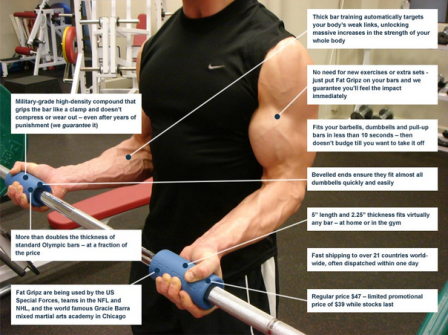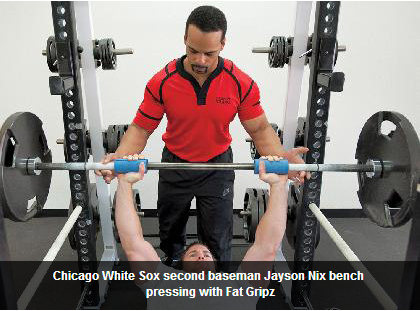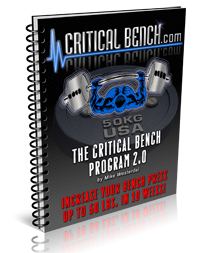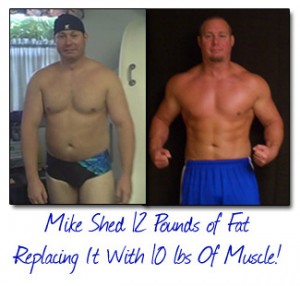Working out to strengthen your grip or develop your wrists requires specialty equipment that only a few gyms actually offer. This is what Fat Gripz aims to help users with in addition to providing better traction whenever there is a need to lift dumbbells, barbells, and other types of workout equipment.
I heard about Fat Gripz from a friend of mine in the gym and I have to admit that is was indeed curious. This is what prompted me to write this review and help readers determine whether Fat Gripz is the real deal.
So what exactly does Fat Gripz have in store for weightlifters? Let’s discuss its features and how it can benefit every weightlifter and deliver excellent workout results – something that a lot of weightlifters strive to achieve in their routines.
Understanding Fat Gripz Features and Benefits
Fat Gripz are simply rubber grips that will fit almost any type of bar or cable if you do resistance training to shape your arms. As simple as they may look however, I was quite surprised at how these grips work upon closer inspection. For starters, Fat Gripz traction grips are made from a high density military-grade compound which has been proven to be quite durable and resistant to wear and tear. If you’ve been using regular bar grips in one form or another when you go to the gym you may have noticed that they don’t feel the same as you progress in your workouts. Those of poorer quality will probably even have dents or your fingers may sink in the rubber whenever you try to use them to grip a barbell or a dumbbell. With Fat Gripz, you get firm hand holds every time, therefore reducing the risk of accidental slips that may cause injury. [wplapdance name=”FatGripz”]
Another important feature that Fat Gripz offers to users is the amount of impact felt immediately on the first workout using the grips. If you’ve always had issues with lifting weights to get your arms into the shape you want them to be because you feel that ordinary barbell lifts, pull ups, and curls don’t do you any good, Fat Gripz addresses all these. The impact felt with each workout using these high-grade grips is most noticeable after the lifting routine, as you will really feel that your muscles have been put to the test with the soreness you will. The best part is you don’t need to purchase expensive specialty equipment just to be able to achieve the results you want.
Perhaps the biggest benefit that users can gain from using Fat Gripz is that it develops strength not only in your wrists but also in your forearms. While reading up on grip strength development and training, I found out that this is the one issue many weightlifters face over the years. Although they have big biceps and triceps, the truth is that their grip and forearm strength has been compromised because the bars and cable attachments used in their workouts don’t provide any impact or additional resistance. It is quite easy to pick up a barbell or dumbbell and continue day in and day out with your arm building exercises, but after a few months, the body will recognize the same workout pattern and will start to adapt. Without the extra impact, your grip and forearm strength can become stagnant. This is what you want to prevent because you don’t want to experience a plateau.
How to Use Fat Gripz
Fat Gripz high grade grips are ridiculously easy to use. You just clamp them on any standard bar or cable attachment and you’re good to go. What I like about them is that they come with beveled edges that make setting up the equipment painless and hassle free. Once you have them clamped, you can immediately start your usual workout routine. The difference is that there is now more resistance and impact felt in your forearms than before, and this is what will strengthen your grip and forearm strength.
I’ve been using Fat Gripz for about two weeks now and I must say that I always have them handy whether in the gym or at home where I have a small set of barbells and dumbbells I use whenever I don’t have time to sweat it out in the gym. In the past two weeks, I have noticed a huge difference in the way my grip strength has become, and as a bonus, the pain I feel in my wrists is no longer there – something that I’ve been dealing with since I started lifting weights to get back into shape. I’ve been planning to invest in a fat bar for months, but because Fat Gripz has provided the same results as you would expect from specialty equipment I guess I just saved a lot of money.
Price and Recommendation
When you go to the Fat Gripz website, you can purchase a pair of Fat Gripz for just $39. Those who want to try it can order from the official site here. Although you may think that $39 is too expensive for such simple grips, I recommend that you try them anyway and you will realize just how much value you get for your money. Fat Gripz is covered by what is called the Immediate Impact Guarantee. The developers promise users that they will feel the impact the first day they start using Fat Gripz and if not, a refund can be processed per request.
I’ve always been very careful of the equipment I use in my weightlifting routine, so I was really skeptical about Fat Gripz at first. After trying it for a couple of weeks however, I can honestly say that the product works and that I’ve seen gains I normally wouldn’t have if I stuck with the old regular bars and continued to ignore my grip strength training. Fat Gripz is an ideal addition to your workout arsenal, and I suggest that you try it out as well.





 when the gun goes off to start the swim, and ends when you cross the finish line after the run. That means your event time includes the total of your swim, the time it takes you to transition from swimming to cycling (commonly called transition 1, or T1), the time it takes you to complete the bike ride, the time it takes you to transition from cycling to running (commonly called T2) and your run time.
when the gun goes off to start the swim, and ends when you cross the finish line after the run. That means your event time includes the total of your swim, the time it takes you to transition from swimming to cycling (commonly called transition 1, or T1), the time it takes you to complete the bike ride, the time it takes you to transition from cycling to running (commonly called T2) and your run time.


